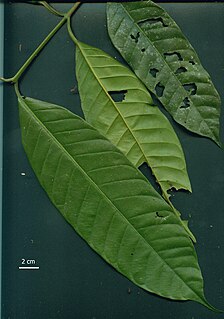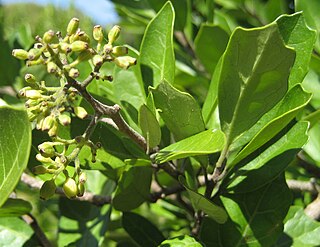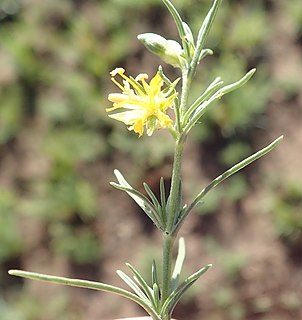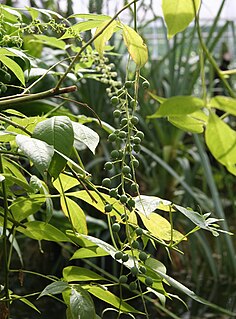
The Potamogetonaceae, commonly referred to as the pondweed family, is an aquatic family of monocotyledonous flowering plants. The roughly 110 known species are divided over six genera. The largest genus in the family by far is Potamogeton, which contains about 100 species.

Virola is a genus of medium-sized trees native to the South American rainforest and closely related to other Myristicaceae, such as nutmeg. Species are known commonly as epená, patricá, or cumala. They have glossy, dark green leaves and clusters of tiny yellow flowers, and may emit a pungent odor.

The family Pandaceae consists of three genera that were formerly recognized in the Euphorbiaceae. Those are:
Lebrunia bushaie is a flowering plant species of the family Calophyllaceae and the sole species comprised in the genus Lebrunia. The plant is native to Africa.

Caraipa is a plant genus in the family Calophyllaceae.

Kielmeyera is a plant genus in the family Calophyllaceae. It is endemic to South America, with a large occurrence in the Brazilian cerrados.

Marila is a plant genus in the family Calophyllaceae. The genus comprises about 20 species, occurring in the Neotropics from Mexico and the Antilles to Bolivia.

Poeciloneuron is a plant genus in the family Calophyllaceae. It contains a single species, Poeciloneuron indicum.
Ctenolophon is the only genus in the flowering plant family Ctenolophonaceae. It has two recognized species:

Malesherbia is a genus of flowering plants consisting of 25 species in the Passifloraceae. This is a xerophytic group endemic to the Peruvian and Chilean deserts and adjacent Argentina. The genus is currently recognized by the APG III system of classification in the family Passifloraceae, and is the sole member of the subfamily Malesherbiaceae.

Ruppia, also known as the widgeonweeds, ditch grasses or widgeon grass, is the only extant genus in the family Ruppiaceae, with eight known species. These are aquatic plants widespread over much of the world. The genus name honours Heinrich Bernhard Rupp, a German botanist (1688-1719). They are widespread outside of frigid zones and the tropics.

Pittosporaceae is a family of flowering plants that consists of 200–240 species of trees, shrubs, and lianas in 9 genera. Habitats range from tropical to temperate climates of the Afrotropical, Indomalayan, Oceanian, and Australasian realms. The type genus is Pittosporum Banks ex Gaertn.

Pennantia is the sole genus in the plant family Pennantiaceae. In older classifications, it was placed in the family Icacinaceae. Most authorities have recognised three or four species, depending on whether they recognised Pennantia baylisiana as a separate species from Pennantia endlicheri. Mabberley, however, has recognised only two species. Pennantia species grow naturally in New Zealand, Norfolk Island, and eastern Australia. In Australia, P. cunninghamii grows across a broad latitudinal natural range, from the south coast of New South Wales northwards through to north eastern Queensland.
Perebea is a genus of plant in family Moraceae.
Pseudolmedia is a flowering plant genus in the mulberry family (Moraceae). Species are found in southern Mexico, the Caribbean, and Meso- and South America. They are known in Latin America as lechechiva and used for timber, construction wood, and sometimes in folk medicine.

Vahlia is a genus of herbs and subshrubs that grow in Africa and the Indian subcontinent. There are at least five species.

Gerrardina is a genus of two species of trees, shrubs, and scrambling shrubs found in southeastern Africa. Until recently, the genus was placed in the polyphyletic family Flacourtiaceae, but it was abnormal there due to its apical placentation, small embryos, and mucilaginous foliar epidermis. Analyses of DNA data indicated that the genus did not fit in any known plant family and not clearly in any then-recognized order, and a new family, Gerrardinaceae, was thus created for it. Later analyses of additional DNA data and data from wood anatomy indicated that the family should be placed in the order Huerteales.
Setchellanthus caeruleus is a species of pungent shrub with large blue flowers. It is placed alone in genus Setchellanthus, which is in turn placed alone in family Setchellanthaceae. It is endemic to Mexico.

Tovaria is a genus of herbs native to Jamaica and South America. There are two species, Tovaria pendula and Tovaria diffusa. The genus is the only one in the family Tovariaceae.

Sphenoclea is a genus of succulent erect annual herbs. They occur in damp habitats throughout the tropics.














